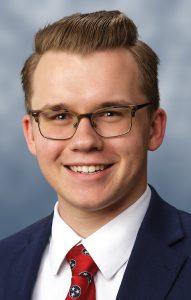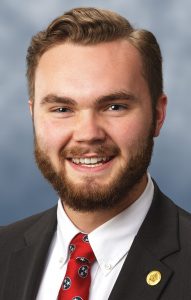Five seminarians who all study at Holy Trinity Seminary in Irving, Texas, have moved into a former convent at St. John Vianney Parish in Gallatin that has been turned into a temporary formation house.
“They’re happy to have the quasi-semblence of a formation house that we were able to cobble together” with the help of St. John Vianney Pastor Father Stephen Gideon and Bishop J. Mark Spalding, said Father Austin Gilstrap, director of vocations for the Diocese of Nashville.
“They’re trying to function like they would at seminary as much as they can,” praying together and taking classes online, Father Gilstrap said.
“They’re all in great spirits,” he said. “They’re really just a great group of guys anyway.”
The five seminarians are Christian Hamrick and Preston Thompson, who are in their third year of college seminary, Reed Robinson and Nathan Schachle, in their second year, and Sklyer Cummings, in his first year.
“All of us were actually looking forward to it,” Hamrick said of moving to St. John Vianney. “One of the things you missed the most … is that community life, community prayer, things like that.”
“There’s nothing quite like it,” added Thompson, who like Hamrick is a graduate of St. Edward School and Father Ryan High School. “The relationships … (that) the community has developed. And how great these guys are you’re living with, who are all seeking the same goal of holiness.
“It’s hard to explain that even to your parents, who you love,” Thompson said.
All of the diocese’s seminarians are continuing to take classes online, Father Gilstrap said, but most are still living at their seminaries.
“We thought that it would be safer and better for them and conducive for their seminary formation if they remained at their seminary, even taking online classes,” Father Gilstrap said.
Besides Holy Trinity, the diocese has seminarians studying at Notre Dame Seminary in New Orleans, St. Meinrad Seminary in Indiana, St. Joseph Seminary in Covington, Louisiana, and the North American College in Rome.
Augustine Mang, the seminarian at North American, has returned from Rome.
Notre Dame is located in New Orleans, one of the country’s hotspots for the COVID-19 virus. “They’ve been taking extra precautions since the beginning of Lent,” Father Gilstrap said of Notre Dame’s administrators. “The guys aren’t allowed to leave. They put all their classes online.”
The Notre Dame seminarians, like those at St. Meinrad and St. Joseph, are being kept away from employees, are practicing social distancing, washing their hands frequently and wearing masks, Father Gilstrap said.
“The effort they’ve made is trying to keep COVID from breaching the outer defenses of the seminary itself,” he said.
While most of the seminarians were still at school when their classes were moved online, the Holy Trinity seminarians were home for spring break when they got the word that the campus had been shut down.
“We were all kind of hanging out at our homes,” Thompson said. Going in and out of the house was difficult, he said, because of the fear of exposing their families to the COVID-19 virus.
“Seminarians love being at home,” Father Gilstrap said. But when they are taken out of the routines of community life and prayer they experience in the seminary, “some men really struggle. They don’t even feel like seminarians.”
The Holy Trinity seminarians had to wait to move into the old convent at St. John Vianney until Mang and Fathers Rhodes Bolster and Luke Wilgenbusch, who are all studying in Rome, moved out. The three had to be quarantined for 14 days after returning from Italy, one of the countries hit hardest by the virus.
After they moved out, the building was thoroughly cleaned and disinfected, even though none of the three had shown any signs of having the virus, Father Gilstrap said.
The five Holy Trinity seminarians moved in on Holy Thursday after they were checked to make sure they were not showing any signs of the virus.
“I’d say we’re pretty good so far,” Hamrick said. “The first step was getting through the Triduum, figuring out what those liturgies would look like, helping Father Gideon and Father Luke,” who is staying at St. John Vianney while home from Rome.
The seminarians also had to figure out community life, settling on a prayer schedule, deciding on a rotation for preparing meals, making sure they keep the place clean, making arrangements for their online classes, Hamrick said.
“It resembles the way our prayer life is at Holy Trinity,” Hamrick said, with morning prayer and Mass with Father Wilgenbusch at 7:30 a.m. and evening prayer at 5:30, followed by dinner. The seminarians are also using a chapel in the house to pray a Holy Hour and are praying the Angelus as a community, Hamrick said.
The seminarians will stay at St. John Vianney at least through the end of the school year.
“We’ll have to wait to see what happens with the COVID after that,” Father Gilstrap said. If some of the stay-at-home restrictions are lifted and the diocese can again celebrate public Masses, the seminarians are likely to spend a short time at home before moving on to their summer assignments. If the restrictions are still in place, the seminarians are likely to stay at St. John Vianney, living as a community.
Deacon formation moves online
Just as the education of the diocese’s seminarians has moved online, so has the formation classes for the diocese’s class of candidates for the permanent diaconate.
The normal schedule for the 14 deacon candidates, who come from throughout the diocese, was to gather in Nashville one weekend a month for 12 hours of classes, several hours of spiritual and pastoral formation, and community prayer.
But beginning in March, everything moved online, said Father Gilstrap, who is overseeing the deacon formation program.
“In March we had a large Zoom conference,” Father Gilstrap said. “The teacher was on Zoom, all the men were on Zoom. … We’re prepared for both April and May to be entirely online.”
The men will have a break from classes during June and July, with hopes they can return to the normal schedule in August, Father Gilstrap said.
“This is not a sustainable model,” Father Gilstrap said of moving the program online. “My hope is we are back to normal by August.”
The current class of deacon candidates is in the second year of a four-year formation program. The diocese is reviewing applicants for a second class, which is scheduled to start in August, Father Gilstrap said.
“We’re still moving forward. A number of men are in the application process right now,” said Father Gilstrap, who is interviewing candidates. “I’m just doing them over Zoom now.”











